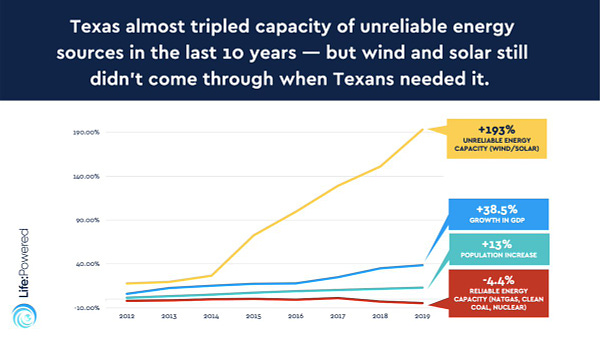Hello!
As temperatures plummeted in Texas recently, Texans began to experience wide-spread power-shedding and blackouts across the state. Power shortages from various power facilities were made worse by a corresponding rise in demand, exceeding all anticipated worst-case planning scenarios.
This week’s letter is my attempt to break down some of the more nuanced arguments behind the Texas Blackouts into more simple terms.
Scenes of people sitting in their cars for hours on end with the engines running to keep warm, and darkened buildings with the lights turned out began to circulate on social media.
It was a remarkable set of circumstances, and devastating for millions of Texans directly impacted, lives lost, and not to mention the estimated economic fallout of almost $20 billion.
Then, as sure as night follows day, the blame game started!
Quite quickly the argument became polarized into two basic camps.
Many argued that the blackouts were caused by frozen solid wind turbines, and more broadly in a failure of renewable energy to show adequate resilience when it was needed.
Many such as the famous New York Democratic Representative, ‘AOC’, claiming that the crisis was caused as a direct consequence of not investing enough in renewable energy.

No doubt the reality behind the cause of the blackout is somewhat more complex and multi-variate than a binary debate reduced down to simply ‘thermal energy’ vs ‘renewable energy’.
Given how deeply ingrained in political culture green energy, and ‘sustainability’ more generally has become, these battle lines are somewhat inevitable.
Some terms:
We refer to ‘GW’ when talking about power generation. GW stands for gigawatts. A watt is a unit of power, and more precisely is the number of joules of energy generated per second. A ‘giga’, is 1 billion. So for example, 50 GW is shorthand for 50,000,000,000 (fifty billion) joules per second of power.
In the case of the Texas power grid we refer to ‘ESCOT’. ESCOT is The Electric Reliability Council of Texas, which operates Texas's electrical grid.
In this article, renewable energy refers to the power generated from wind turbines and solar panels. Thermal energy refers to power generated from gas and coal-fired power plants.
What Happened?
As with many disasters on this scale, there was a compounding effect from multiple unfortunate events.
First of all, there was a near total loss of wind output. One of the fundamental problems with renewable sources is that reserve capability is often not available when needed. There is a total of 32 GW of wind power available in Texas, which dropped to as low as 1 GW during the crisis. In general, wind & solar both over & under-performed the 6.2 GW of output that ERCOT had planned for.
Freezing and fuel shortages in gas pipelines caused many natural gas plants offline, and many coal plants likely struggled with frozen coal piles.
Natural gas is the largest provider of power in Texas, accounting for 56 GW, or 66% of total capacity ERCOT was planning to have available during winter peaks. Of a total of about 70 GW of thermal plants (also including coal), approx 25-30 GW went offline.
It didn’t help matters that the week previous to the Texas storms, wind power was operating at a relatively high capacity, and therefore natural gas capacity had been lowered to adapt, at exactly the point at which you would ideally be building up thermal capacity. When wind power ‘dropped off a cliff’, the backup was not adequate.
A nuclear station reactor also failed, losing 1.2 GW of lost capacity.
Localized power outages from transmission & distribution failures also occurred in the extreme weather conditions such as downed lines, overloaded transformers, etc.
How resilient is the system?
In total, power outages ranged from 25-30 GW. This was more than double what ERCOT considered an ‘Extreme Generation Outage during Extreme Peak Load’.
Moreover, peak winter demand hit 69 GW, but had used an ‘extreme’ planning scenario of 67 GW.
Renewable energy as a share of total power supply has increased dramatically , tripling in the last 10 years. Even the biggest renewable energy proponents cannot escape the fundamental fact that such sources cannot be relied upon in extreme circumstances, reflected in the reliance figures that ERCOT placed on their energy sources mentioned above.


The burden of reliance is, quite correctly, placed on thermal power generation to help in extreme circumstances. In this case, however, there was inadequate contingency planning, and so when much of the thermal power generation failed, the capacity was found wanting.
If reliance is put on thermal energy sources which themselves were not found adequate when it was needed, then the question remains:
Why reduce the amount of more reliable energy sources relative to less reliable sources, when overall reliability has been shown to be inadequate?
Wherever renewable energy is relied upon, typically gas plants are required in any case to act as backup.
Texas’ plans for new power plants looks something like the following:
0 nuclear
0 new coal plants
9.4 GW wind
11.9 GW solar
5.0 GW gas (as backup for the renewable sources)
Also note that the Biden administration plans for almost 100% renewable energy by 2035.
One can argue for investing further into renewable energy in order to increase its own resilience through such technologies as large scale battery deployment, but of course such technologies bring with them their own set of economic and environmental challenges.
Either way, I cannot help but agree with Alex Epstein’s conclusion, that it is not about ‘frozen wind turbines’, just as it is not about the failure of any of the thermal fuels themselves, but rather about a series of policy decisions that have left the entire grid less capable of responding to extreme conditions:

(I must also credit Alex Epstein for the sub-heading used in this letter!)
Thanks for reading!
-Tristan




